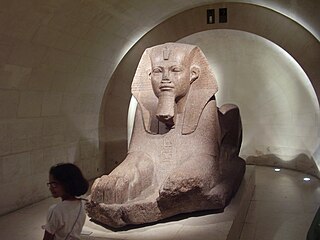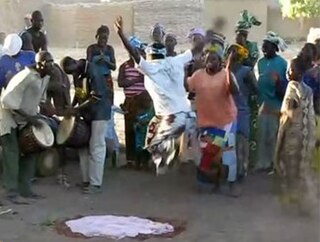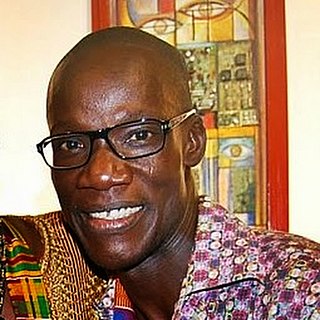
The Maasai are a Nilotic ethnic group inhabiting northern, central and southern Kenya and northern Tanzania, near the African Great Lakes region. The Maasai speak the Maa language, a member of the Nilotic language family that is related to the Dinka, Kalenjin and Nuer languages. Except for some elders living in rural areas, most Maasai people speak the official languages of Kenya and Tanzania, being Swahili and English.

The balance beam is a rectangular artistic gymnastics apparatus and an event performed using the apparatus. Both the apparatus and the event are sometimes simply referred to as "beam". The English abbreviation for the event in gymnastics scoring is BB. The beam is a small, thin beam which is typically raised from the floor on a leg or stand at both ends. The balance beam is only performed competitively by female gymnasts. Beams are usually covered with leather-like material and are only four inches wide.

Aerobics is a form of physical exercise that combines rhythmic aerobic exercise with stretching and strength training routines with the goal of improving all elements of fitness. It is usually performed to music and may be practiced in a group setting led by an instructor. With the goal of preventing illness and promoting physical fitness, practitioners perform various routines. Formal aerobics classes are divided into different levels of intensity and complexity and will have five components: warm-up, cardiovascular conditioning, muscular strength and conditioning, cool-down and stretching and flexibility. Aerobics classes may allow participants to select their level of participation according to their fitness level. Many gyms offer different types of aerobic classes. Each class is designed for a certain level of experience and taught by a certified instructor with a specialty area related to their particular class.

The Samburu are a Nilotic people of north-central Kenya. Samburu are semi-nomadic pastoralists who herd mainly cattle but also keep sheep, goats and camels. The name they use for themselves is Lokop or Loikop, a term which may have a variety of meanings which Samburu themselves do not agree on. Many assert that it refers to them as "owners of the land" though others present a very different interpretation of the term. Samburu speak the Samburu dialect of the Maa language, which is a Nilotic language. The Maa language is also spoken by other 22 sub tribes of the Maa community otherwise known as the Maasai. Many Western anthropologists tried to carve out and create the Samburu tribe as a community of its own, unaffiliated to its parent Maasai community, a narrative that seems that many Samburu people today hold. There are many game parks in the area, one of the most well known is Samburu National Reserve. The Samburu sub tribe is the third largest in the Maa community of Kenya and Tanzania, after the Kisonko (Isikirari) of Tanzania and Purko of Kenya and Tanzania.

The Kalenjin are a group of tribes indigenous to East Africa, residing mainly in what was formerly the Rift Valley Province in Kenya and the Eastern slopes of Mount Elgon in Uganda. They number 6,358,113 individuals per the Kenyan 2019 census and an estimated 273,839 in Uganda according to the 2014 census mainly in Kapchorwa, Kween and Bukwo districts.

Lion dance is a form of traditional dance in Chinese culture and other Asian countries in which performers mimic a lion's movements in a lion costume to bring good luck and fortune. The lion dance is usually performed during the Chinese New Year and other traditional, cultural and religious festivals. It may also be performed at important occasions such as business opening events, special celebrations or wedding ceremonies, or may be used to honour special guests by the Chinese communities.
The Pentozali or Pentozalis is the trademark folk dance of the island of Crete. It takes its name from the fifth (pente) attempt or step of the Cretan people to liberate Crete from the Ottoman Empire. It can thus be translated as "five-steps". The name also contains an element of wordplay, as ‘ζάλη’ means dizziness, and so it may also be interpreted as a dance that can make its dancers dizzy five times over ("five-dizzy"). In fact the dance has ten steps in total.

African dance refers to the various dance styles of sub-Saharan Africa. These dances are closely connected with the traditional rhythms and music traditions of the region. Music and dancing is an integral part of many traditional African societies. Songs and dances facilitate teaching and promoting social values, celebrating special events and major life milestones, performing oral history and other recitations, and spiritual experiences. African dance uses the concepts of polyrhythm and total body articulation. African dances are a collective activity performed in large groups, with significant interaction between dancers and onlookers in the majority of styles.
The Gisu people, or Bamasaba people of Elgon, are a Bantu tribe and Bantu-speaking ethnic group of the Masaba people in eastern Uganda, closely related to the Bukusu people of Kenya. Bamasaba live mainly in the Mbale District of Uganda on the slopes of Mount Elgon. The Bagisu are estimated to be about 1,646,904 people making up 4.9% of the total population according to the 2014 National Census of Uganda.
The ISU Judging System or the International Judging System (IJS), occasionally referred to as the Code of Points (COP) system, is the scoring system that has been used since 2004 to judge the figure skating disciplines of men's and ladies' singles, pair skating, ice dance, and synchronized skating. It was designed and implemented by the International Skating Union (ISU), the ruling body of the sport.
Kilgoris is a town in Narok County, Kenya. The town has a population of 70,475. Kilgoris is one of two major urban centres in Narok County, the other being Narok town.

The culture of Assam is traditionally a hybrid one, developed due to cultural assimilation of different ethno-cultural groups under various political-economic systems in different periods of its history.

Heritage commodification is the process by which cultural themes and expressions come to be evaluated primarily in terms of their exchange value, specifically within the context of cultural tourism. These cultural expressions and aspects of heritage become "cultural goods," transformed into commodities to be bought, sold and profited from in the heritage tourism industry. In the context of modern globalization, complex and often contradictory layers of meaning are produced in local societies, and the marketing of one's cultural expressions can degrade a particular culture while simultaneously assisting in its integration into the global economy. The repatriation of profits, or "leakage", that occurs with the influx of tourist capital into a heritage tourist site is a crucial part of any sustainable development that can be considered beneficial to local communities. Modern heritage tourism reproduces an economic dynamic that is dependent upon capital from tourists and corporations in creating sustained viability. Tourism is often directly tied to economic development, so many populations see globalization as providing increased access to vital medical services and important commodities.

Russian folk dance is an important part of Russian culture. Some of the unique characteristics suggest that many elements were developed by the early Russian population.
TeamGym is a form of competition created by the European Union of Gymnastics. The first official competition was held in Finland in 1996. Originally named EuroTeam, TeamGym received its current name in 2002. From 1996 to 2008, the European Championships was an event for clubs; since 2010 the competition is contested with national teams representing different countries. TeamGym events consist of three sections: women, men and mixed teams. Gymnasts perform skills in three different disciplines: floor, tumbling and trampette. In common for the performance is effective teamwork, good technique in the elements and spectacular acrobatic skills.
European dances refers to various dances originating in Europe. Since Medieval ages, many European dances tend to be refined, as some are based on the court dances of aristocrats.
The Maasai Cricket Warriors (MCW) is a Kenyan men's cricket team formed in 2007 by semi-nomadic people from Laikipia County. Consisting of 25 players and a counterpart women's team, it participates in semi-professional tournaments aboard, including in London primarily focused on raising funds and awareness through charity cricket and uses its athletic fame for the promotion of women's rights, campaign against female genital mutilation, child marriage, substance abuse, and Environmental Conservation In Kenya in Kenya.

Moribayassa is a traditional dance that the Malinke people of West Africa first performed. Women generally engage in the dance to express their emotions and seek spiritual purification.

Ukusina is a type of traditional dance that has its roots in South Africa's coastal region. For the Zulu people, it is an expressive and rhythmic dance form with deep cultural importance. The Ukusina requires dancers to kick their legs in any direction up and out, and then stamp each foot into the ground. The majority of the time, this dance is performed for entertainment during social occasions such as wedding ceremony. Ukusina dances, as a result, are socially created and center on the song leader singing interlocking word phrases. Traditionally, it was thought that no religious event would be complete without at least one ukusina dance performance. Ukusina dance is a fundamental component of the social, religious, and cultural life of the Zulu people, as evidenced by the descriptions of traditional dances in South Africa. Everyone in attendance is drawn into a coherent action atmosphere by the intimate relationship between body movement and music.

Anuang'a Fernando, Kenyan choreographer and dancer, born on October 12, 1972. Growing up in Kitengela and Magadi, he developed interest in Maasai dance and tradition. He is dedicated to the preservation and development of traditional Maasai dance and the fusion of Maasai dance with contemporary styles.














